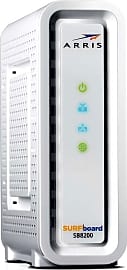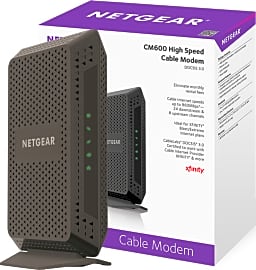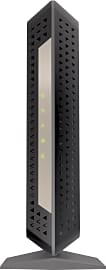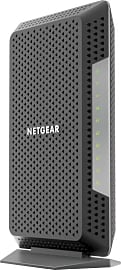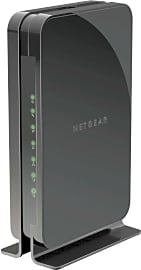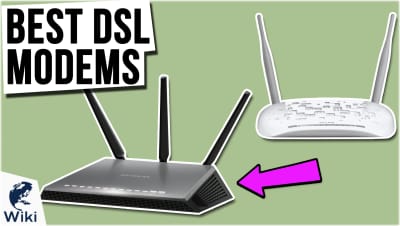The 7 Best Cable Modems

This wiki has been updated 38 times since it was first published in June of 2015. Nobody should pay monthly rental fees for a cable modem when there are so many reasonably priced and powerful models for sale. Many Internet plans can be accommodated with an inexpensive model, but high-speed connections will need something more advanced. Make certain to check with your ISP over the phone or on their website, to be sure the modem you select is officially approved for your plan. When users buy our independently chosen editorial picks, we may earn commissions to help fund the Wiki.
Editor's Notes
January 07, 2021:
First of all, make sure to check with your specific ISP to ensure that the modem you choose is compatible. For what it's worth, the majority of up-to-date modems will be compatible with many modern ISPs, but some have specific requirements that a few otherwise-good modems don't quite meet. You can almost always find a list of approved modems on your ISP's website.
There hasn't been a whole ton of advancements in modem technology recently, but there has been some. We did replace the Motorola MB8600 with the Motorola MB8611, which is newer and only a hair more expensive, while also being significantly more advanced.
Otherwise, we moved the Motorola MB7621 to the top spot due to its impressively low price and its two-year warranty, which surpasses that of others with similar prices and performance. We also eliminated the Netgear CM500, because it's no longer very much less expensive than many of the faster options.
April 02, 2019:
First of all, if you're in the market for a cable modem, there are two things you should generally avoid buying. One is a combination modem and router. They are generally much more problematic than separate devices because they can't be provided with the same firmware updates that many routers require over their lifespan, and they don't even really save you any money. The second is a 32x8 channel DOCSIS 3.0 modem, as these are run by what's called the Intel Pump 6 chipset, which has exhibited a fatal flaw that causes troublesome latency spikes and disconnects. It's been this way over the entirety of the chipset's lifespan (nearly two years), so there's no reason to believe that Intel will be rolling out a fix anytime soon. Finally, if you don't plan on upgrading to gigabit-class service in the forseeable future -- and most people in the USA don't even live in regions that offer it, nor will most of the rest of us ever need that kind of bandwidth -- then you probably don't need to shell out big bucks to be an early adopter of DOCSIS 3.1. If you're into future-proofing your setup, though it is something to consider.
With that out of the way, if you're on a budget and don't plan on streaming multiple 4K videos at the same time while someone else is playing games, the Netgear CM500 base model may be your best bet. The Motorola MB7621 is only a bit more expensive, though, and can provide upgraded performance, especially for networks with a lot of users. On the other end of the spectrum, the Arris SurfBoard and Netgear's CM1000 and CM1150V provide next-level DOCSIS 3.1 functionality in addition to exceptional DOCSIS 3.0 backward compatibility, though they are considerably pricey. Plus, Netgear's voice-enabled modems are generally limited to the Comcast Xfinity phone+cable bundled packages. In the middle of the performance range are the TP-Link and Motorola's higher-end unit, but the Netgear CM600 may be the best of the bunch (for most users, anyhow), simply because it provides excellent real-world speeds at notably reasonable price.
What Type Of Cable Modem To Buy
You can also install different router firmware if you desire.
From a technical standpoint, there are two types of cable modems. You have older, one-way cable modems that run over standard coaxial cable networks. They only offer download speeds up to 2 Mbps and actually have no upload capacity.
Luckily this slow, one-way approach has been mostly phased out by now, and there is very little chance you'll even see this kind of cable modem for sale anymore. The newer type of cable modem is a hybrid fiber/coax modem. These run over HFC cables which are considerably faster and offer download and upload capacity.
From a consumer viewpoint, there are also two types of cable modems, both of them being hybrid fiber/coax models. Since the older one-way cable modems aren't really being sold anymore, they won't have to factor into your decision making. Your choice will come down to standard cable modems and cable modem/router combos.
A standard cable modem will give you access to the internet, but won't provide your home with any WiFi signal. If you have a standard cable modem and you want WiFi, you'll have to purchase a separate wireless router. On the other hand, a 2-in-1 cable modem/router combo gives you both internet and WiFi access from one unit.
Each of these types has their own benefits and drawbacks. 2-in-1 models are more space efficient, as you won't need to find room for two separate units, and they also allow for a cleaner looking installation since there will be less cables and you'll only be using one power outlet.
2-in-1 models also allow you to get setup and running quicker as you don't need to configure two separate devices. They are also easier to troubleshoot. If one part of the device stops working though, the entire unit needs to be replaced and combo units are more expensive than replacing just a modem or router.
Separate units allow for more control over features. For example, with a dedicated router, you can enable a dynamic DNS or prioritize your network traffic using QoS features. You can also install different router firmware if you desire. Dedicated routers generally provide slightly faster WiFi speeds as well. For the average person though, a combo unit can provide everything you need as most people won't know how or why to use these advanced features and the speed boost probably won't be noticeable.
Cable Modems Versus DSL Modems
Both cable modems and DSL modems provide always-on high speed internet access. DSL offers this via the use of a dedicated phone line, while cable modems provide internet access through the use of a shared cable television line.
In theory, a cable modem offers faster internet speeds, but in practice this isn't always true.
In theory, a cable modem offers faster internet speeds, but in practice this isn't always true. Because cable networks are set up like shared local area networks (LAN) with many users sharing the same bandwidth, actual speeds can vary dramatically. The more users there are online at the same time, the slower your internet speed will be. You may find that you have blazing fast internet speeds late at night when people are sleeping, but in the evenings, when more people are using the internet, your downstream speeds may be cut in half.
DSL internet speeds are more consistent than cable as each user has their own dedicated line, but at the best of times, cable internet speeds outperform DSL by far. In addition to consistency, another advantage to DSL is better security. Since you aren't sharing a connection, it is harder for a hacker to access your personal network. A big disadvantage to DSL is that proximity to your internet service provider (ISP) can make a huge difference on the actual download and upload speeds you experience. Uploads are also far slower than downloads when using a DSL connection.
Internet Speeds Across America
Every year internet speeds have increased dramatically across the United States and other countries. The average household received speeds of 10 Mbps in 2011, and by 2014 that had jumped up to 31 Mbps. In 2015, the FCC redefined broadband quality internet speeds to be at a minimum of 25 Mbps downstream and 3 Mbps upstream.
And as one final note, don't let the difference between megabits and megabytes confuse you.
Until recently, cable modem download speeds topped out around 100 Mbps, with uploads maxing out at 8 Mbps. The new DOCSIS 3.1 version has significantly increased that and allows for up to 10 Gbit/s downstream and 1 Gbit/s upstream. Gigabit speeds were first offered to select areas of Atlanta, followed by adoption in a number of large US cities. It's certain that the technology will expand as the infrastructure is further developed, but the average user won't need that kind of bandwidth anytime soon.
4K streaming requires about 25 megabits per second for stutter-free playback, which even some moderately priced home services can handle without many hiccups. If (or when) 8K video becomes mainstream, even that will require at most around 100Mbps, and by 2019, plans offering hundreds of gigabits of throughput started to become far more accessible in major metropolitan areas, again with further adoption to follow. Do keep in mind, of course, that ISPs and hardware manufacturers alike always advertise the theoretical maximum speeds, and because of the overhead effect on bandwidth, real-world speeds tend to be no more than 50% to 60% of advertised rates.
And as one final note, don't let the difference between megabits and megabytes confuse you. A byte consists of exactly 8 bits, and they're generally used to refer to two different things. Fixed amounts of data, such as file sizes and storage capacities, are almost always referred to as bytes, which you'll see when you check on how much of your 512-gigabyte drive you've filled up with TV shows. Bits, on the other hand, generally refer to transmission units, and in the case of Internet bandwidth, they refer to throughput rates. It's a subtle yet important distinction, and one to keep in mind as you're following the ever-advancing World Wide Web.



